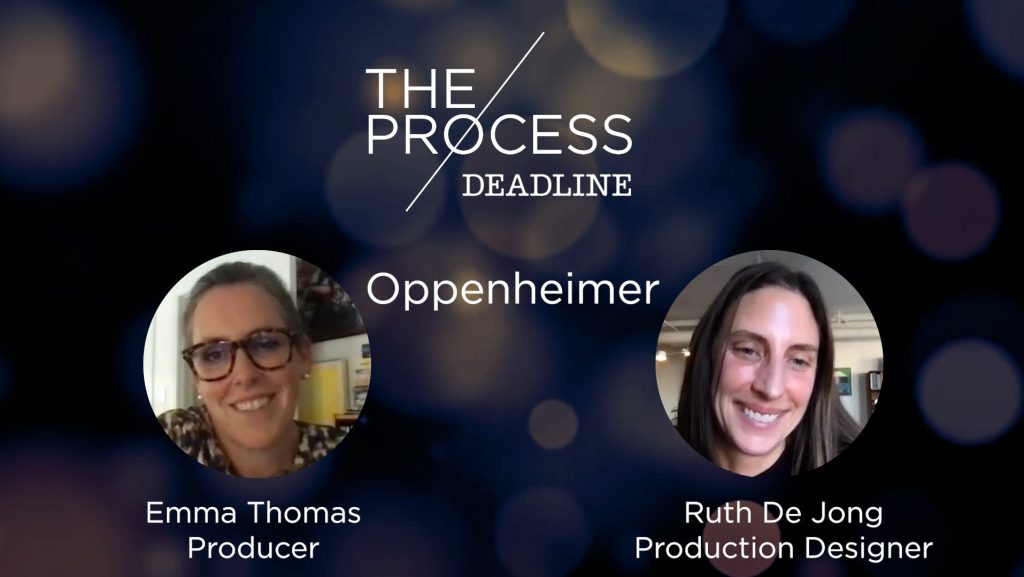
While for production designer Ruth De Jong, it would’ve been ideal to be well rested ahead of her first collaboration with Christopher Nolan on his Uni historical epic Oppenheimer, she wound up boarding the project with Jordan Peele’s alien invasion pic Nope just barely in the rearview mirror.
Emma Thomas, the producer of Oppenheimer and wife of Nolan who has worked alongside him since the late 1990s, marvels at this prospect, which she images left De Jong with “no room to breathe.” But in conversation with Thomas on the process, De Jong explains that the quick turnaround between projects proved to be a net “positive,” if only because she “didn’t have time to get scared.”
RELATED: Universal “Working To Replenish” Sold-Out Stock Of ‘Oppenheimer’ 4K Discs In Time For Holidays
On Nope, De Jong had worked with Hoyte van Hoytema and Scott Fisher, the cinematographer and special effects coordinator who would likewise carry over to Oppenheimer, so by the time Oppenheimer‘s below the line team began working together, there was plenty of “energy and synergy” going right into the project.
Based on the Pulitzer Prize-winning book American Prometheus: The Triumph and Tragedy of J. Robert Oppenheimer by Kai Bird and the late Martin J. Sherwin, Nolan’s latest stars Cillian Murphy as the theoretical physicist, who we follow at work on the creation of the atomic bomb, as part of the Manhattan Project.
From early conversations with Nolan, De Jong understood that he was going for an aesthetic as “modern” as it was “timeless,” where just the right amount of accurate period detail would be layered into “simple” frames.
For De Jong, a couple of the most challenging environments to bring to life for Oppenheimer were the government-funded community of Los Alamos, New Mexico, the “massive” scale of which had to be captured on a less-than-massive budget, as well as the tower and basecamp for the Trinity testing site where the first nuclear test was conducted.
Thomas admits that Oppenheimer was “enormously ambitious” in relation to its budget, in the same way Dunkirk was, with De Jong pointing out that 150+ sets were erected over the course of the 57-day shoot. Thomas equates the process of bringing the film to fruition to walking “through fire,” singling out the pre-production process as particularly “bumpy” given the fact that production materials were “massively expensive” at the time of the shoot, which was happening shortly in the aftermath of Covid. Then, of course, there was the challenge of reconciling “the desire for what the world was going to be with the realities of how we were going to achieve that.”
Critical to that process, Thomas explains, was a period early on in pre-production that Nolan devotes to “pure creativity,” a time the filmmaker has come to value “massively” and brought into all his projects since Batman Begins. “We don’t bring our line producer on, we don’t bring our DP. We don’t bring anybody on,” Thomas explains. “It’s literally just about the pure blue sky thinking of what the project can be, creatively speaking, before the reality sets in and you have to start dealing with logistics.”
RELATED:Imax Sees Quarterly Revenue Surge Led By ‘Oppenheimer’, Stock Pops
When introduced to Nolan’s process of “garage time” reflection, after going through something similar with Peele on Nope, De Jong found it to be “the smartest thing ever.”
“Carrying that over with Chris was thrilling because it was so effective with Jordan. But also, Chris was a brand-new director who I didn’t have a shorthand with,” the designer explains. “We didn’t know each other and the expectations, and it gave us that time to work all of that out without any noise…[as far as] the logistics of time, budget and money…The possibilities were endless, and it was wonderful.”
Going on to gross over $950M worldwide upon its release over the summer, Oppenheimer was written and directed by Nolan, with Thomas producing alongside Atlas Entertainment’s Charles Roven.
Other topics covered in our Process installment on the film include why Thomas never goes on location scouts, the concept of “medium resistance” from Nolan and Thomas’s artist friend Tacita Dean and how it informs their work, the qualities that Thomas most values in production design, the “many miracles” performed on set by De Jong, borrowing an Oval Office set from Veep when a location fell through at the last minute, and more. View the full conversation above.













